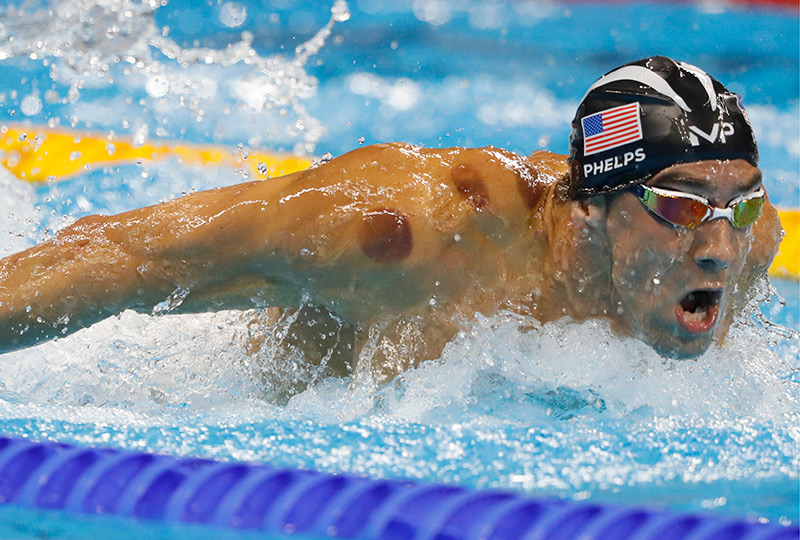U.S. Olympic athletes like Michael Phelps are making cupping famous. What’s this ancient Chinese practice about?
Many Southerners are unfamiliar with cupping, or were until the Olympic games opened in Rio de Janeiro. We all noticed the strange red circles marking the skin of swimmer Michael Phelps, gymnast Alex Naddour and others. This therapy is more common in China, where it’s been practiced for many centuries.
At the Osher Center for Integrative Health at Vanderbilt, Chongbin Zhu, Ph.D., LAC, offers cupping as well as other Chinese medicine practices such as acupuncture.
“Cupping is one of many therapeutic modalities in traditional Chinese medicine,” Zhu explained. “It places a special cup or jar (bamboo, glass or clay) on the skin to create negative pressure (vacuum or suction), to achieve the effect of removing blockages, promoting local energy and blood circulation, and relaxing local soft tissues.”
Cupping therapy is most often used in combination with acupuncture, moxibustion (burning herbs), massage and sometimes other techniques, Zhu said.
Small-scale studies have found that people with pain — chronic neck or low-back pain, for example — experienced short-term improvement (typically a few weeks) in pain and functioning after a series of cupping sessions. There have not been large-scale scientific studies on cupping.
“For the past 2,000 to 3,000 years, cupping has been used over and over to help people with good results,” Zhu said. “In my own clinical career, I witnessed the effectiveness of cupping in a variety kinds of chronic pain and other conditions.”
Alex Diamond, MPH, D.O., team physician to the Nashville Sounds, Nashville Predators and Vanderbilt and Belmont universities’ athletes, says that in his sports medicine practice, he doesn’t typically recommend cupping to patients. But, “I am certainly not against it in the right setting by the right professional. In fact, I’m very open to those types of modalities,” Diamond said. “It’s not a new treatment, as it has been around for ages in eastern medicine.”
Diamond said that other alternative medicine techniques, such as acupuncture, osteopathic manipulative medicine, reiki or chiropractic care, can be helpful. Patients should check with their doctor to be sure such therapies are safe for them, he added.
Here Zhu answers our questions about cupping:
How is cupping done?
Traditionally, a flammable substance (for example, alcohol, herbs or paper) is burned in a cup. When the flame goes out (normally in few seconds), the cup is rapidly placed upside down on the patient’s skin. The hot air rising in the upside-down cup creates a vacuum effect and causes the skin to rise and redden as blood vessels expand and the muscles stretch.
In recent decades, a more modern version has become popular. It’s an air pump-assisted method. A special cup is hooked up with a rubber pump and placed on the skin. The pump, rather than a flame, creates the vacuum effect. The cup is typically left in place for about 10 minutes.
What conditions can this treat?
Does it hurt?
No.
How long do results last?
Patients can feel the results from a couple of hours to several days after the first treatment. The cumulative effect can last a week to several weeks. It varies for different conditions and individuals.
How long do the red marks last?
The marks typically last for several days.
Are there any side effects or risks?
It’s generally a safe treatment when administered by qualified practitioners, with very few side effects. The most common side effects are bruises (cupping marks), mild discomfort or skin infection if the cupping is not done properly.
Who can benefit from cupping?
Anyone with the aforementioned conditions can benefit — in particular, people with chronic pain; muscle stiffness, sprains or spasms; stress; anxiety; and high blood pressure.
Are there people who should not do it?
Pregnant women, people with metastatic cancer and people with bone fractures should not undergo cupping. Also, the cups should not be applied to sites on the body that have a deep vein thrombosis, an ulcer or a large artery.
How can people find qualified practitioners?
Any National Certification Commission for Acupuncture and Oriental Medicine-certified and licensed practitioner of acupuncture/traditional Chinese medicine will be qualified.

